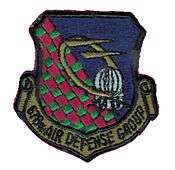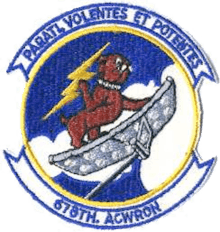678th Air Defense Group
The 678th Air Defense Group is a disbanded United States Air Force organization. Its last assignment was with the 20th Air Division of Air Defense Command (ADC) at Tyndall Air Force Base, Florida. The group was formed in 1970 when ADC expanded its radar units that operated Back-Up Interceptor Control sites from squadron sized units to groups. From 1977 until it was inactivated in 1983 the 678th was responsible for operating the Southern Air Defense System.
| 678th Air Defense Group | |
|---|---|
| Active | 1970–1983 |
| Country | |
| Branch | |
| Role | Air Defense |
| Part of | Aerospace Defense Command (1970–1979) Tactical Air Command (ADTAC) (1979–1983) |
| Decorations | Air Force Outstanding Unit Award |
| Insignia | |
| Subdued Patch with 678th Air Defense Group emblem |  |
History

The 678th Air Defense Group replaced the 678th Radar Squadron (SAGE) (formerly the 678th Aircraft Warning & Control Squadron) at Tyndall Air Force Base in 1970.[1] The group operated a Back-Up Interceptor Control (BUIC) site with the mission to back up the centralized and vulnerable Semi-Automatic Ground Environment (SAGE) operations center of the 20th Air Division at Gunter Air Force Base, Alabama. The BUIC III operated by the group gave the unit a semi-automatic control capability, unlike earlier BUIC systems that required manual operation.[2] The group provided air defense mission command and control from 1970 to 1983. It was a component of Aerospace Defense Command (ADC) (later transferred to Tactical Air Command (TAC)) Air Defense Weapons Center from 1974 to 1981. The group earned an Air Force Outstanding Unit Award for exceptionally meritorious service for the period 1 June 1970 through 1 June 1972.[3]
In 1969, the inadequacy of the radar coverage to the south of the United States had been dramatically illustrated whan a Cuban Mikoyan-Gurevich MiG-17 went undetected before it landed at Homestead Air Force Base, south of Miami, Florida.[4] and two years later, an Antonov An-24 similarly arrived unannounced at New Orleans International Airport.[4] As a result, ADC established The Southern Air Defense System (SADS). Initially, the 630th Radar Squadron operated a manual control center at the Houston Air Route Traffic Control Center and the USAF added radars to supplement the existing Federal Aviation Administration coverage in the Caribbean area.[4] In 1977, responsibility for operating the SADS control center was transferred to the group, which was operating the last BUIC III site in ADC.[5] The previous year the group also assumed responsibility to operate the Tyndall NORAD Control Center.
The group continued to act as a control center until it was inactivated in 1983 when the Tyndall radar site became part of the Joint Surveillance System.[1]
Lineage
- Constituted as 678th Air Defense Group on 13 February 1970
Assignments
- 20th Air Division, 1 March 1970 – 1 March 1983[1]
Components
None
Stations
- Tyndall AFB, Florida, 1 March 1970 – 1 March 1983 30°04′35″N 085°36′35″W[1]
References
Notes
- Cornett & Johnson, p. 85
- "BUIC III for Tyndall AFB (reproducing article from Communications & Electronics Digest, Aug 1968)". Radomes, Inc. Retrieved 21 August 2014.
- AF Pamphlet 900-2, Unit Decorations, Awards and Campaign Participation Credits, Vol II Department of the Air Force, Washington, DC, 30 Sep 76 , p. 87
- Leonard. Vol I, p. 172
- "TNCC: ADCOM/s rewest control center (reproducing article from Rampart, Aug/Sep 1977)". Radomes, Inc. Retrieved 21 August 2014.
- Department of the Air Force/MPM Letter 575q, 27 September 1984, Subject: Disbandment of Units
Bibliography
![]()
- Cornett, Lloyd H; Johnson, Mildred W (1980). A Handbook of Aerospace Defense Organization, 1946–1980 (PDF). Peterson AFB, CO: Office of History, Aerospace Defense Center.
- Leonard, Barry (2009). History of Strategic Air and Ballistic Missile Defense (PDF). Vol I. 1945–1955. Fort McNair, DC: Center for Military History. ISBN 978-1-4379-2131-1.
- AF Pamphlet 900-2, Unit Decorations, Awards and Campaign Participation Credits, Vol II Department of the Air Force, Washington, DC, 30 Sep 76
Further reading
- Winkler, David F.; Webster, Julie L (1997). Searching the skies: The legacy of the United States Cold War Defense Radar Program. Champaign, IL: US Army Construction Engineering Research Laboratories. LCCN 97020912.
External links
- "Information for Tyndall AFB". Radomes, Inc. Retrieved 21 August 2014.

